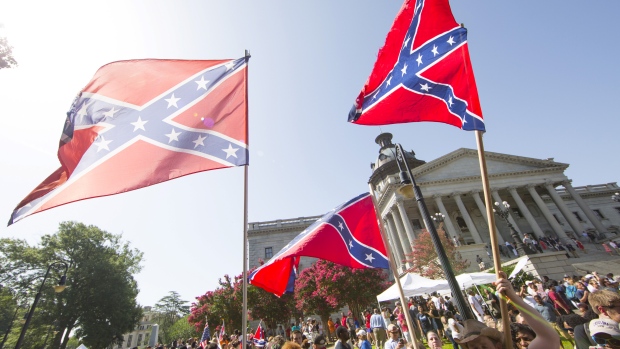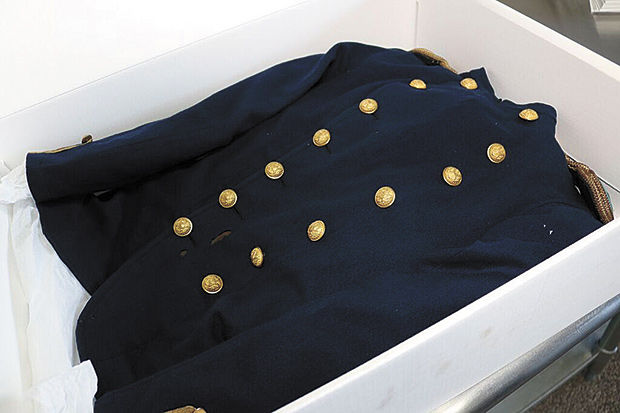CANADA: Norfolk County Fair Vendors Told to Stop Selling Confederate Flag
Two vendors at the Norfolk County Fair in Ontario, Canada were told to stop selling merchandise featuring the Confederate flag after complaints from a visitor to the Thanksgiving weekend fair.
Justin Erdman said he was at the annual fall fair on Saturday night from 7:30 p.m. until closing time, and something he saw there surprised him.

The Confederate flag, removed from public grounds in South Carolina in 2015, is a widely-reviled symbol, but still has its supporters. The design was featured on merchandise at 2016’s Norfolk County Fair. (Jason Miczek/Reuters)
“Several vendors had Confederate battle flags in their wares — one in Building 5 featured them prominently at the cash register. Others had them emblazoned on hats and shirts with the word ‘Rebel’ over top,” Erdman said.
“All the fair has to do is issue an order to vendors. Simple. But I haven’t heard any response from the fair,” he said, referencing tweets he’d directed at the fair’s twitter account on Saturday night and Sunday morning.
George Araujo, the fair’s general manager, told the CBC on Sunday afternoon that they had not seen Erdman’s tweets. Araujo said he was not aware of the Confederate flag merchandise, but said he would investigate and make sure anything violating their regulations is removed.
“We do have regulations against anything offensive,” Araujo said, “and we’ll have to take a look and see if that qualifies.”
Asked if the Confederate flag would qualify as offensive, Araujo said, “It would depend on how it’s displayed or how it’s being used. I haven’t seen it, so I can’t comment on that.”
However, Araujo later informed the CBC that “we did do a look around our grounds, and we did find a couple of articles that we found objectionable that incorporated the Confederate flag design, and we required that the vendors remove them from display for sale.” Those items were hats and mini-flags available from two separate vendors.
‘Overwhelmingly racist connotations’
The Confederate flag, a symbol from the days of the U.S. Civil War over slavery, continues to stir up controversy. Many people have called for it to be removed from public places because of its relationship with slavery and white supremacy.
Dylann Roof, the 21-year-old man who is alleged to have killed nine African American people worshipping at the historic Emanuel AME Church in Charleston, South Carolina in June of 2015, proudly displayed the flag. Photos of Roof with the flag were found after the shooting, along with photos of Roof burning the American flag. His trial is set to begin Nov. 7.
“It was so unnecessary,” said Erdman. “It’s an American symbol, and one that they have taken steps in the past couple years to eliminate from public display because of its overwhelmingly racist connotations.”
“This is Canada. And Ontario,” Erdman said. He thinks it’s especially offensive in the context of “a town like Simcoe that employs workers of all colours at harvest time — literally keeping the economy going.”
Controversy about the flag in the Hamilton area is not new — a now-shuttered barbecue restaurant called Hillbilly Heaven in the city’s International Village displayed and later removed the flag in 2013.
Gerald Horne, a professor of history at the University of Houston, said at that time that historically Canada has been ardently anti-slavery and nearly became the target of U.S. attacks for it.
“The confederate flag stands for slavery,” Horne said at the time. “It stands for backwardness. It stands for reactionary politics. It stands for going backwards.”
–cbc.ca
###
MINNESOTA: Civil War Uniform Restored to Former Glory
STILLWATER, Minn. — Though the great battlefields of the Civil War were mostly located in the eastern states, Minnesota has quite a few strong connections to the historic struggle. In this case, the connection came to Stillwater in the form of an original Union soldier uniform, which was expertly restored to museum quality by Treasured Garment Restoration.
The uniform originally belonged to Leonard G. Dennis, who served in the Union army as a teenager. Dennis was originally from Massachusetts, but served in Florida during the war, and made his home there after the war ended. He later served as a state senator in Florida, and was best known for being involved with the ballot-stuffing scandal that threw the 1876 presidential election to the Republican nominee, Rutherford B. Hayes.
Duane Schumann is the restoration production manager at Treasured Garment Restoration. He performed most of the restoration work on the uniform personally.
“It’s really cool because this piece is small, [it looks like] it was for a 12-year-old kid,” Schumann said. “[Dennis] was known as the Little Giant; they made a play on his initials. He has a history with politics. Being that we’re going through this political state and this is part of the Civil War, this is pretty cool.”
The uniform was sent to Schumann by a family from Florida, some of Dennis’ great-great-great-grand relatives who have passed down the artifact as a family heirloom. Schumann said the family once attempted to offer it to a museum, but the process was complicated by a change of curators, and the family wound up keeping it instead. They found Treasured Garment Restorations online, and inquired about restoration. Schumann was more than pleased to take a look. After the finishing touches are added, the uniform will be mounted in a shadow frame to display in the family’s residence.
This historic artifact is particularly notable, but Treasured Garment Restoration takes on unusual and historic projects all the time, Schumann said.
The business began in 2008 as a specialty cleaning division of St. Croix Cleaners. Based in Stillwater, Treasured Garment Restoration specializes in cleaning, pressing and preserving wedding gowns and restoring garments and textiles that are damaged by age, fire or water. Services also range to vintage restoration as well as specialty cleaning of costumes and high-end materials. Treasured Garment Restoration partners with a multitude of local theaters, including the Guthrie Theatre and the Children’s Theatre. Schumann said he has also taken on work from the Minnesota Historical Society, preserving some of the historic garments that are on display at the History Museum.
“Vintage restoration is my favorite thing to do,” Schumann said.
His interest in old artifacts began early — he remembers going to thrift stores with his grandmother and being fascinated by the styles of clothing he saw. He was especially intrigued by the way lace was made. Eventually, he began working for a leather cleaning company, learning the precise methods for removing blemishes from leather. This was followed by a stint in dirt redemption, which taught him a lot about how to extract grime and chemicals from contaminated materials.
“When they dig up gas stations and cleaners that have toxic ground, they would bring it to us, so that’s how I learned to do pH sampling,” Schumann said. He brought this chemical expertise back to the field of restoration when he moved back into the cleaning business, offering fire and vintage restoration before joining Treasured Garment Restoration. Over the years he said he has built a camaraderie with the Minnesota Historical Society, and has done quite a few pieces for museums.
“If you asked the Historical Society for someone who could restore vintage clothes, they would refer you to me,” Schumann said. “It just turned into a tremendous job. I don’t look at it as a job; it’s a fun place to come.”
Restoration can be very delicate work, Schumann said.
“You definitely have to focus in on what you’re doing; there’s a lot of patience and testing and research,” Schumann said. “The challenging part is when you have something that old and you’re trying to work around insect holes. Basically, when you have a hole in anything, the strength of the fiber is compromised. The area around that is very weak. So to try to get around those areas that are missing some fabric without tearing or distorting is challenging.”
Over the years, Schumann has developed a specific formula for ensuring the best results in the restoration process.
“I’ve been developing it for a while, and it allowed me to do some of these artifacts and be able to get the trust and respect of the historical society,” he said. “Saturation, agitation and extraction. We developed a method to restore vintage fibers that are weakened without destroying them. We’ll use tag cloth and cheesecloth to wet it down, and that’s where the agitation comes in, as far as blotting and forcing some of the solvent into the material. Then we allow solvent-based cleaner to roll into the piece, with no pressure. Then we use a multi-stage vacuum, pulling out impurities to bring it back to a lustrous look.”
With the application of this method to the uniform, Schumann was able to preserve it just as he would a museum artifact. He said restoring the uniform was definitely an exciting endeavor.
“It’s really a neat piece of history,” Schumann said. “There’s not a lot of pieces floating around that are original Civil War pieces, and when you find them, it’s good to know it’s not forgotten.”
To learn more about Treasured Garment Restoration, visit treasuredgarmentrestoration.com.
–presspubs.com
###



